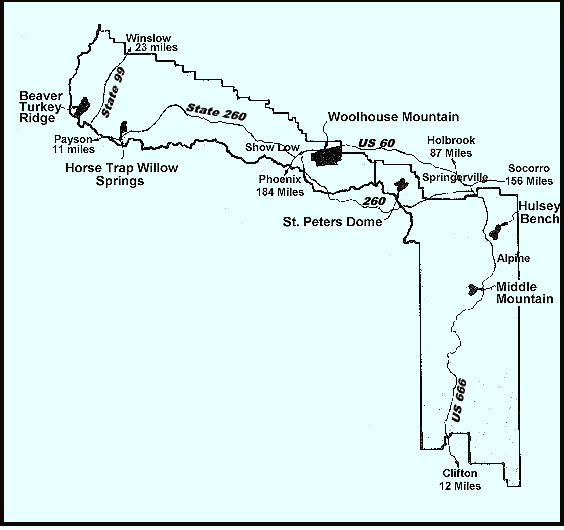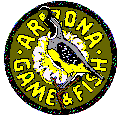Quiet Places...Quiet Times
 Background: Background:
In 1985, the Apache-Sitgreaves National Forests and
Arizona Game and Fish Department
announced an innovative wildlife habitat program aimed at improving wildlife
habitat, wildlife viewing, photography, and hunting opportunities. Five
wildlife habitat areas were established on the forest that were closed to the
use of motorized vehicles. Since that time, two more areas have been added and
one area was deleted for a current total of six habitat areas. Although
wildlife habitat areas have been established in other states, this was the
first extensive program of its kind in southwestern National Forests.
Objectives:
The primary objective of the program is to provide wildlife,
particularly species such as elk,
deer, and
turkey, habitat which is free from
motorized vehicle disturbance. The quiet areas that are created through the
exclusion of motorized vehicles allow more effective use of key habitat by
wildlife species for foraging, nesting, and reproductive activities. These
areas can be particularly beneficial for wildlife when adjacent areas have
ineffective vegetative cover, high open road densities, and motorized vehicle
use. Thus, the improvement in "habitat effectiveness" for wildlife is a
key benefit of the program.
 The management objectives of each area may differ since
they are established to meet particular species needs. Some areas emphasize elk
habitat, calving areas in particular; other emphasize fawning areas for deer;
and still others emphasize habitat for wild turkey. Several areas have
objectives for multiple species, but one common thread runs through them all,
there are definite benefits to all wildlife found in each area. The management objectives of each area may differ since
they are established to meet particular species needs. Some areas emphasize elk
habitat, calving areas in particular; other emphasize fawning areas for deer;
and still others emphasize habitat for wild turkey. Several areas have
objectives for multiple species, but one common thread runs through them all,
there are definite benefits to all wildlife found in each area.
In addition to wildlife objectives, these areas are managed to
protect soil, vegetation, and water resources. Visitors to the
Apache-Sitgreaves are invited to continue using these non-motorized areas.
Generally these areas would not require you to walk more than two miles from an
open road.
Wildlife Habitat Area Descriptions:
Hulsey Bench Wildlife Habitat Area is located on the
Alpine Ranger District. It is generally described as the gentle bench land
immediately west of Escudilla Wilderness. It encompasses much of the headwaters
of Watts Creek, Milk Creek, and Hulsey Creek. Visitors to this area may see
mule deer, elk, turkey, bear, bobcat, fox, and if you are lucky, you might
catch a glimpse of an elusive mountain lion. This is also an excellent area for
bird watchers.
Beaver Turkey Ridge Wildlife Habitat Area is
generally described as the land area encompassed by Turkey Creek, Beaver
Canyon, and the Mogollon Rim and is located on the Chevelon Ranger District.
This area, like most wildlife habitat areas is very popular with deer, elk, and
turkey hunters. It is also a great place for
hiking, horseback riding,
and mountain biking.
Horse Trap Willow Springs Wildlife Habitat Area is
within the area bounded on the west by Woods and Chevelon Canyons, on the south
by Willow Springs Lake Recreation Area and on the north and east by Forest Road
237. It is on the Heber Ranger District. This area is important as an elk
calving area. If you hike into the area, large groups of elk may be observed
grazing along the closed roadbeds. Popular activities besides
wildlife viewing and hunting include
mountain biking and hiking.
St. Peter's Dome Wildlife Habitat Area is the land
area encompassed by Forest Roads 117, 118, and 117A and is a mile northeast of
Greens Peak on the Springerville Ranger District. This is an excellent area for
archery hunting, hiking, horseback
riding, and photography. Elk, deer, and turkey can be seen throughout the area.
This area is most popular during late summer and fall.
Middle Mountain Wildlife Habitat Area is a gentle to
moderately steep south and southwesterly facing area of land that lies between
Beaver Creek and Middle Mountain on the Alpine Ranger District. This area is
closed to motorized vehicles from August 15 until December 31. This seasonal
closure provides security and cover to elk, deer, and turkey and is especially
important during hunting season. Large herds of deer and elk have been observed
in this area. Early morning and evening should provide wildlife photographers
and viewers the best opportunities.
Woolhouse Wildlife Habitat Area is the land area
bounded on the north by U.S. Highway 60, on the south by Forest Road 45, and on
the east by the Navajo and Apache County line. It is north and east of Porter
Mountain on the Lakeside Ranger District. Woolhouse is a large area and is more
of a challenge to hikers and hunters. This area is closed to motorized vehicles
year-round and because of this, increasing numbers of elk can now be seen in
the area.
 Benefits: Benefits:
Some of the benefits of area closures to motorized vehicles
are:
- Reduced disturbance and stress to wildlife during critical
periods (e.g., nesting), resulting in healthier animals and lower mortality
rates.
- Improved the quality of wildlife viewing and hunting
experiences for individuals seeking solitude and undisturbed animals.
- Provide wildlife the opportunity to make more effective use of
all habitat.
- Reduced motorized vehicle disturbance to vegetation, soil, and
water resources.
- Reduced road maintenance needs and costs.
Public response to the wildlife habitat areas has been
overwhelmingly in favor of continuing and/or expanding the program. Hunters
enjoy what they consider a "quality hunt," free from the disturbance of
motorized vehicles. Photographers and wildlife viewers are able to see abundant
deer, elk, turkey, numerous species of
birds, and much more
throughout the recreation season.
Any opposition to motorized restrictions has been mainly from
individuals or groups with concerns about visitors who may not be physically
able to walk through these areas. Since the total mileage affected is only
around one percent of all travel ways on the Apache-Sitgreaves, visitors with
physical impairments still have opportunities to enjoy thousands of miles of
roads that remain open to vehicular traffic.
Permitted access with motorized vehicles is limited to only that
which is an absolute necessity or emergency. For example, some areas have
powerline or waterline permits where it is sometimes necessary to use motorized
equipment for maintenance. Also, the designation of these areas does not
preclude other on-the-ground management activities, such as timber harvesting
and grazing.
The remaining six areas are re-evaluated periodically by a team of
Forest Service and Arizona Game and Fish Department personnel. The team looks
at numbers of violations, effects on soil, cost to manage, and other factors.
Than, a decision is made for each area to do one of three things: keep the area
the same, delete the area, or adjust the area's boundaries. The Swale Area, on
the Heber Ranger District was dropped in the late 1980s during the latest
re-evaluation process. There was little pressure from motorized vehicles, and
there were no appreciable benefits to wildlife.
If we have whetted your appetite...
with these brief descriptions of the six wildlife habitat areas, be our guest
and visit one of these national forest "quiet places." Try out that new
mountain bike. Hike an area and see how many different species of wildlife you
can observe or photograph. Enjoy nature's spectacular fall color or just get
away from your favorite campground and enjoy this unique part
of...AMERICA'S GREAT OUTDOORS. |


 Background:
Background: The management objectives of each area may differ since
they are established to meet particular species needs. Some areas emphasize elk
habitat, calving areas in particular; other emphasize fawning areas for deer;
and still others emphasize habitat for wild turkey. Several areas have
objectives for multiple species, but one common thread runs through them all,
there are definite benefits to all wildlife found in each area.
The management objectives of each area may differ since
they are established to meet particular species needs. Some areas emphasize elk
habitat, calving areas in particular; other emphasize fawning areas for deer;
and still others emphasize habitat for wild turkey. Several areas have
objectives for multiple species, but one common thread runs through them all,
there are definite benefits to all wildlife found in each area. Benefits:
Benefits:
